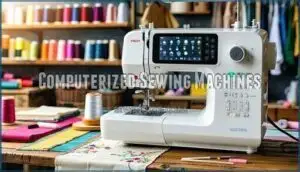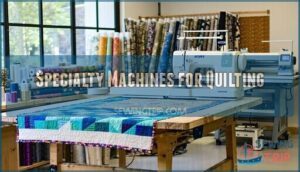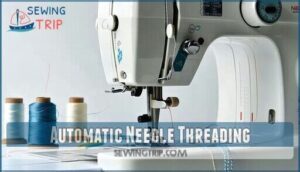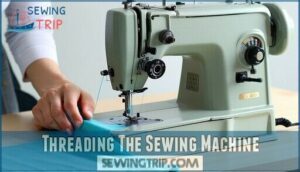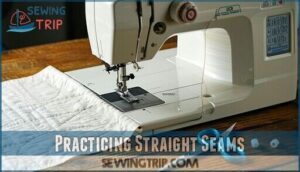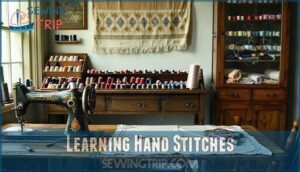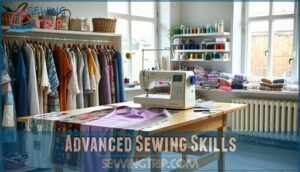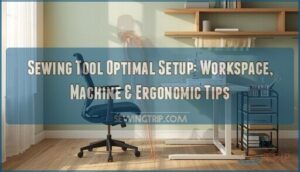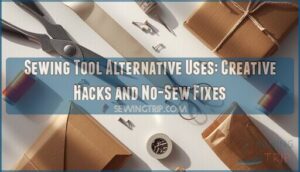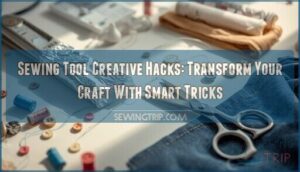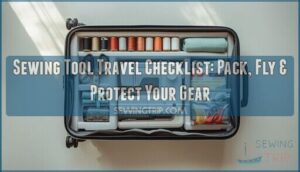This site is supported by our readers. We may earn a commission, at no cost to you, if you purchase through links.
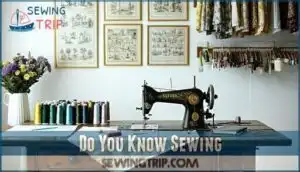
You’ll start with basic hand stitches and machine operation, then progress to more complex techniques like hemming, zipper installation, and pattern reading.
The journey from threading your first needle to creating custom garments is incredibly rewarding.
Modern sewing machines offer computerized features that make learning easier, while traditional hand-sewing techniques remain timeless.
Success comes from understanding your tools, practicing fundamental stitches, and gradually building confidence with each project.
The key is starting simple and embracing the learning process.
There’s something magical about transforming plain fabric into something beautiful and functional.
Table Of Contents
Key Takeaways
- You’ll start with basic hand stitches and machine operation – Begin by learning fundamental techniques, such as straight seams and threading your machine properly, before advancing to complex projects.
- You need three key foundations: machine, tools, and workspace – Choose a sewing machine that fits your budget ($100-200 for beginners), gather essential tools, like fabric scissors and quality thread, and organize your workspace for efficiency.
- Success comes from practicing fundamental stitches and building confidence gradually – Master basic techniques on scrap fabric first, then progress to advanced skills, such as hemming, zipper installation, and pattern reading, through consistent practice.
- You can transform plain fabric into beautiful, functional creations – Whether you’re making simple repairs or custom garments, sewing opens up endless creative possibilities once you’ve mastered the basics and embraced the learning process.
Sewing Basics Explained
You’ll need three key foundations before you start sewing: choosing the right machine for your skill level and budget, gathering essential tools like sharp fabric scissors and quality thread, and setting up an organized workspace that keeps everything within reach.
The three sewing essentials—machine, tools, and workspace—unlock your creative potential from day one.
These basics will transform your sewing experience from frustrating fumbles into smooth, enjoyable projects that actually turn out the way you planned, with essential tools, smooth experiences, and an organized workspace.
Sewing Machine Selection
When choosing your sewing machine, consider your budget first—beginner models start around $100 while computerized options begin at $200.
Machine types vary from basic mechanical to advanced computerized models with enhanced stitch quality and sewing speed.
Read sewing machine reviews and buying guides to compare features like automatic threading and maintenance requirements before making your final selection.
Understanding the sewing machine options is essential for making an informed decision.
Essential Sewing Tools
Now that you’ve got your sewing machine sorted, let’s talk about the sewing tools that’ll make your projects shine.
You’ll need sewing needles for both hand and machine work, plus fabric scissors that cut like butter. Stock up on thread types in basic colors, grab measuring tools like a measuring tape, and consider starter sewing kits for convenience.
These sewing tools transform frustrating fumbles into smooth sailing. Understanding the role of essential sewing tools is vital for mastering various sewing techniques.
Sewing Workspace Organization
Creating your perfect sewing workspace organization transforms chaotic crafting into seamless creativity.
Invest in sewing tables with built-in storage and dedicated sewing cabinets for machine stability.
Proper workspace lighting prevents eye strain during detailed work.
Use tool organizers for scissors and notions within arm’s reach.
Designate fabric storage bins for scraps and longer bolts.
Your sewing space becomes a productivity haven when everything has its place, promoting an environment of chaotic crafting transformed.
Do You Know Sewing
Since the dawn of civilization, humans have transformed simple fibers into functional art through sewing. This ancient craft has evolved from basic survival necessity into a creative outlet that connects millions worldwide.
Whether you’re drawn to the meditative rhythm of hand stitches or the precision of modern machines, sewing offers a unique blend of practical skills and artistic expression. Sewing History reveals how techniques passed down through generations still influence today’s methods.
Understanding Fabric Types helps you choose materials that match your vision and skill level. The Sewing Community provides support, inspiration, and shared knowledge that accelerates your learning journey. Modern Sewing Patterns offer structured guidance for beginners while challenging experienced sewers.
Textile Science helps you understand how different fibers behave, improving your project outcomes. Your sewing machine becomes an extension of your creativity, transforming ideas into tangible results. Mastering sewing techniques opens doors to endless possibilities, from simple repairs to complex garments.
As you progress, considering fabric selection basics is essential for achieving professional-looking results in your sewing projects.
Choosing Right Machine
You’ve probably wondered if that fancy computerized machine is worth the extra cash or if a basic model will do the trick.
The truth is, choosing the right sewing machine depends on your specific goals, budget, and how much you plan to grow your skills in the coming months.
Computerized Sewing Machines
Computerized sewing machines revolutionize your crafting experience with cutting-edge technology that transforms complex techniques into simple button presses.
These intelligent machines feature built-in computers and LCD touchscreens that guide you through every stitch.
Modern computerized sewing machines offer remarkable capabilities:
- Machine Options – Choose from hundreds of built-in stitches and embroidery patterns with programmable memory functions
- Stitch Variety – Access decorative, utility, and specialty stitches that automatically adjust tension and length
- Thread Control – Enjoy automatic needle threading and thread cutting that saves time and reduces eye strain
- Fabric Sensors – Smart sensors detect fabric thickness and adjust settings while alerting you to low bobbin levels
- Digital Displays – Navigate intuitive touchscreen interfaces that provide step-by-step guidance for ideal results
These computerized sewing machine features eliminate guesswork from sewing machine operation.
The advanced technology handles tension adjustments automatically, reducing common sewing machine troubleshooting issues.
You’ll achieve professional-quality results faster than ever before.
The global market is expected to grow rapidly due to increased demand for sewing machine technology.
Specialty Machines for Quilting
Discover how specialty quilting machines transform your creative journey from basic patterns to masterpiece quilts.
These machines offer precision and speed that regular sewing machines can’t match, making complex projects manageable for beginners and professionals alike.
| Machine Type | Best For |
|---|---|
| Longarm Quilting | Large quilts, professional work |
| Sit-Down Models | Home studios, smaller spaces |
| Multi-Needle | Commercial quilting businesses |
| Frame-Based | Maximum workspace, intricate designs |
| Extension Tables | Increased project capacity |
Quilting machines feature specialized throat space, stitch regulators, and embroidery units that handle multiple fabric layers effortlessly.
Longarm quilting machines reach 3,000 stitches per minute, while sewing automation reduces manual work.
Whether you’re following sewing tutorials or creating original sewing patterns, these machines elevate your quilting experience beyond traditional sewing for beginners approaches.
The larger throat size options are essential for handling bulky quilts and large projects.
Automatic Needle Threading
Automatic needle threading revolutionizes your sewing experience by eliminating the most frustrating part of machine setup.
This built-in feature uses a tiny wire hook to pull thread through the needle’s eye instantly, and modern sewing machines from Brother, Singer, and JUKI include this game-changing technology.
You’ll save precious time and reduce eye strain, especially during complex projects requiring frequent needle changes, which makes this feature a time-saving and eye strain reducing advantage.
Mastering Sewing Techniques
Once you’ve set up your sewing machine and organized your workspace, it’s time to build the fundamental skills that’ll transform you from a beginner into a confident sewist.
These core techniques form the foundation of every project you’ll tackle, from simple repairs to complex garments, and will help you develop into a skilled sewist.
Threading The Sewing Machine
Threading your sewing machine correctly is the foundation of quality stitching.
Start by raising the presser foot to open tension discs, then follow your machine’s numbered threading path.
Wind the bobbin first, guaranteeing proper thread tension throughout.
Insert the needle with the flat side facing back, then use the automatic needle threader if available.
Proper sewing machine threading prevents thread breakage and guarantees consistent stitch quality through balanced machine threading and bobbin management.
Practicing Straight Seams
Perfect timing really matters when you’re sewing straight seams.
Start with quilting cotton—it’s forgiving while you master seam accuracy. Your sewing machine settings play a huge role: adjust thread tension and stitch length for your fabric choice, then control your sewing speed to maintain precision.
- Practice on scraps first – Master straight stitches before tackling your actual project pieces
- Use seam guides – Most machines have markings to help you maintain consistent seam allowances
- Keep steady pressure – Gentle, consistent guidance beats rushing through sewing seams every time
Learning Hand Stitches
You’ll master essential hand sewing techniques that connect you to centuries of craftsmanship.
Start with the Running Stitch for basic seams, then progress to Backstitch for strength.
The Slip Stitch creates invisible hems, while Embroidery Basics open creative doors.
Hand Sewing builds finger memory and precision that enhances all your sewing projects.
Advanced Sewing Skills
You’ve reached the point where basic sewing skills transform into advanced techniques that’ll make your projects look professionally finished.
Now you’ll master complex skills like hemming with precision, installing zippers smoothly, and creating your own custom designs from scratch, which will help you achieve a professionally finished look.
Mastering Hemming Techniques
You’ve mastered straight seams and hand stitches—now perfect hemming gives your garments that professional polish.
Create clean folded hems using essential hemming tools like measuring tape and seam gauge.
Master blind hems for invisible sewing edges that elevate your work, and apply these hemming tips to transform basic sewing techniques into advanced skills through precise sewing machine stitches.
Sewing Zippers and Buttons
A quality zipper foot reveals professional-looking results with invisible zippers, while proper button placement guarantees your garments look polished.
Master shank buttons and buttonholes to elevate your sewing skills beyond basics.
Different zipper types require specific techniques, but consistent practice transforms these challenging sewing notions into manageable tasks.
Understanding invisible zipper techniques is vital for achieving a flawless finish in various sewing projects.
Creating Custom Designs
Beyond traditional sewing patterns, you’ll discover endless possibilities when creating your own unique designs.
Start with fabric selection that inspires your vision, then sketch ideas using design software or paper. Pattern making transforms concepts into wearable art, while textile printing adds personal flair to any project.
To bring these designs to life, understanding the proper use of a sewing machine is essential.
Transform Your Creative Vision:
- Sketch wild ideas – Let your imagination run free on paper before touching fabric
- Mix unexpected textures – Combine silk with denim for surprising contrasts that wow
- Create signature embellishments – Develop your personal style with unique beading or embroidery
- Design functional art – Make everyday items beautiful and completely your own
- Break traditional rules – Experiment with unconventional sewing machine stitch types for stunning effects
Using Patterns for Guidance
When you’re ready to tackle more complex sewing projects, beginner sewing patterns become your roadmap to success.
These sewing instructions guide you through garment fitting, textile selection, and fabric cutting techniques.
Start with simple sewing tutorials that include clear sewing notions lists and step-by-step pattern making guidance.
Quality sewing patterns eliminate guesswork, helping you create professional-looking garments while building confidence in your skills.
Frequently Asked Questions (FAQs)
What are the basics to know about sewing?
You’ll need a sewing machine ($100-200 for beginners), fabric scissors, pins, measuring tape, thread, and needles.
Start with cotton fabric since it’s forgiving.
Learn basic stitches, practice threading your machine, and set up an organized workspace with good lighting for successful projects.
Should you practice sewing for beginners?
Like planting seeds in fertile soil, practice transforms awkward beginnings into skilled craftsmanship.
You’ll definitely want to practice sewing regularly as a beginner—it’s how you’ll build muscle memory, master basic techniques, and gain confidence with your machine before tackling complex projects.
Is sewing for beginners scary?
Sewing isn’t scary for beginners! You’ll find it’s actually quite forgiving – mistakes become learning opportunities.
Start with simple projects like tote bags, practice basic stitches, and you’ll build confidence quickly through hands-on experience.
Why should you learn to sew?
Learning to sew grants creative freedom, saves money on alterations and repairs, and provides a therapeutic outlet for stress relief.
You’ll gain practical skills, express personal style, and create meaningful handmade gifts for loved ones.
How do I know how to start sewing?
Like a seamstress from the 1800s threading her first needle, you’ll start by gathering basic supplies: fabric, thread, scissors, and pins.
Choose a simple sewing machine or hand-sewing needle, then practice straight stitches on scrap fabric to build confidence before tackling your first project.
Do you know how to sew straight lines?
Straight lines become second nature with practice on scrap fabric.
Start slowly, guide the fabric gently, and keep your eyes ahead of the needle, not directly on it.
Consistent speed helps maintain control and accuracy.
Did you know sewing facts?
Ancient Egyptians invented the first sewing machines around 3,000 BCE using bone needles and sinew thread.
You’ll discover sewing connects cultures across millennia, transforming simple fabric into functional art through precise stitches and creative vision.
Is it sewing or sowing?
It’s "sewing" when you’re stitching fabric together with thread and needle. "Sowing" means planting seeds in soil. You’ll sew a dress, but sow your garden with flowers.
What do you call a person that knows how to sew?
A person who knows how to sew is called a seamstress (traditionally female) or tailor (traditionally male).
However, you’ll often hear "sewer" used today as a gender-neutral term for anyone who’s mastered the craft.
Is sewing a talent or skill?
Sewing is definitely a skill you can learn and master through practice.
While some people might’ve natural dexterity that gives them a head start, anyone can develop sewing abilities with dedication and proper instruction.
Conclusion
Like a skilled craftsperson shaping raw materials into masterpieces, you’ve discovered that sewing transforms simple fabric into extraordinary creations.
Whether you’re just asking "do you know sewing" or you’re already threading needles with confidence, remember that every expert started with basic stitches.
Your journey from beginner to advanced seamstress depends on consistent practice and patience.
Modern computerized machines make learning easier, but hand-sewing techniques remain timeless, and by starting simple, you can embrace mistakes as learning opportunities, and soon you’ll create beautiful, functional pieces that reflect your unique style.

